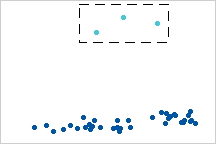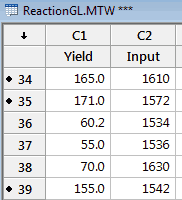Brushed points are a different color


The Brushing palette lists the row numbers of brushed points in the worksheet.
The symbols next to rows 34, 35, and 39 indicate brushed points.

The brushed values in the Yield column seem unusually high.

Selecting one or more data points on a graph to see corresponding worksheet information.
Use brushing to investigate characteristics of data points of interest. For example, in this scatterplot of Yield vs. Input, you can brush suspicious points and get more information about them.
|
Brushed points are a different color
|
The Brushing palette lists the row numbers of brushed points in the worksheet. |
The symbols next to rows 34, 35, and 39 indicate brushed points. |
The brushed values in the Yield column seem unusually high. |
At this point, you can:
|
|
You can add variables to the Brushing palette, so that you can view values for brushed points only. These variables are called ID variables. In this example, the ID variables are Yield and Input. |
You can also create a column in the Data window called an indicator variable that identifies brushed rows with a value of 1 and unbrushed rows with a value of 0 (by default). Use indicator variables as grouping variables for other operations such as regression analysis and subsetting worksheets.
|
Note |
Brushing is not available for graphs in which points represent more than one worksheet row. For example, if data for all subgroups are in one column and each point on a control chart represents the mean of a subgroup, brushing is not available. |